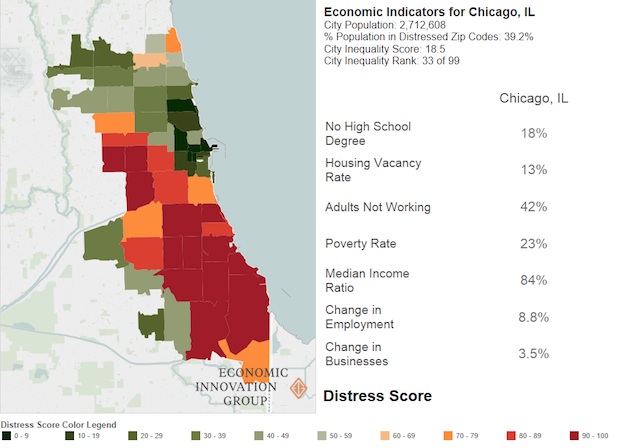Chicago Is Still Segregated By Race And Now 'Distress,' Too
By Mae Rice in News on Mar 1, 2016 3:26PM
If you've lived in Chicago for more than an hour, you know it's a segregated city. It's not the most segregated city in the country—but that changed just as of recently, and just by a hair.
We're segregated racially, as evidenced by this photo set and the study linked above. We're also segregated by "distress," according to the "Distressed Communities Index," recently released by the DC-based Economic Innovation Group.
Check out this infographic—where red is the most distressed terrain, and green the least—and see for yourself:

"Distress" in Chicago, mapped (courtesy of the Economic Innovation Group)
As the legend above suggests, the EIG team used seven different metrics, each weighted equally, to come up with composite "distress scores" between 0 and 100. The metrics were:
Overall, Chicago is the 34th most distressed city in the country. Chicago's denizens, 39.2 percent of them live in "distressed zip codes," defined as those with scores of 80 to 100.
That percentage is "about twice what you’d expect to see given the city’s proportions," EIG cofounder John Lettieri told Chicagoist.
Chicago fits the mold of a disproportionately distressed city, though, Lettieri added.
"Distressed cities tend to be older. The median home in a distressed city was built in 1959; in a prosperous city, it was built in 1989,” he said.
He attributes this to distressed cities' struggle to shift from its "legacy economy" (in Chicago's case, manufacturing) to a more modern "knowledge economy" (white collar jobs, tech, etc.).
Lettieri noted that distressed cities also tend to be segregated, like Chicago. Not only is it visibly divided on the map above; it comes in 33rd on the index for "inequality."
The inequality calculation—which measures how widely distress varies across the city—is weighted by population density. Which makes sense—what matters most is how unequal people are, not how unequal places are.
The map above looks striking—and shows how unlikely it is that a person randomly parachuting into Chicago would land on prosperous territory—but keep in mind that people aren't spread equally over all that space. If they were, the city would be even worse off than it is now!